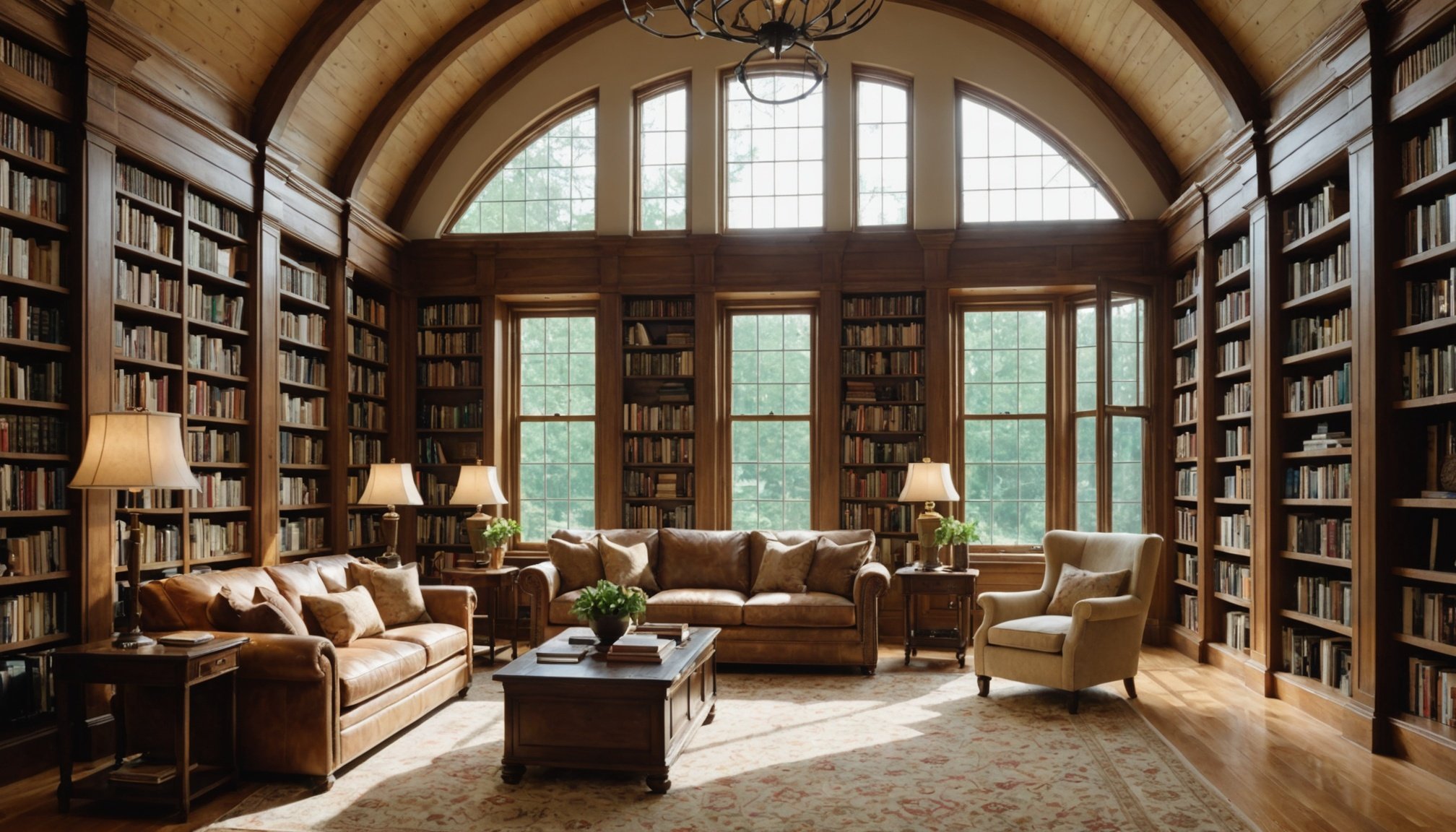Designing the Ideal Home Library
When designing the ideal home library, incorporating natural lighting ideas can transform the space into more than just a reading area; it becomes a haven. Architectural designs that take advantage of large windows or skylights can significantly elevate the ambiance. Styles such as modern minimalist or traditional with large glass panels allow for abundant light, creating a naturally inviting setting.
Choosing the right colour palettes is crucial. Light shades like soft blues, warm whites, or pastel yellows can amplify natural light, whereas darker tones might make your library feel more enclosed. Using mirrors strategically can also enhance light reflection, boosting the overall brightness and warmth of the space.
Also read : Unlock budget-friendly techniques for installing underfloor heating in concrete surfaces
Creating a reading nook concept is all about comfort and accessibility. Position plush seating near windows to maximize sunlight exposure. Consider adding adjustable lamps for nighttime reading. Incorporate shelves that are both aesthetically pleasing and functional, maintaining the open and airy feel of the room.
To ensure a truly inviting atmosphere, complement the architectural design with cozy textiles and personal touches. Rugs, throw pillows, and curated book collections can transform the library into a personal haven while appealing to both your style and practical needs.
Also read : Unveil the best soundproofing solutions for the ultimate home theater experience
Furniture Placement Strategies
Creating a comfortable and well-lit reading space begins with thoughtful furniture arrangement. Begin by arranging seating to allow natural light to flow freely, enhancing illumination in your space. Position chairs and sofas near windows to leverage sunlight throughout the day, which serves as both functional lighting and a mood enhancer.
Selecting ergonomic furniture that supports good posture is essential. Not only does it promote comfort, but it is also crucial in preventing strain during long periods of reading. Consider furniture pieces that are adjustable, like chairs with customizable height features, providing flexibility for all family members.
To optimize your space further, choose multi-functional furniture. For instance, a bookcase with integrated lighting can double as a room divider, improving light reflections. Tables with built-in storage save space while reducing clutter, making your space more inviting and efficient.
Incorporating shelves and bookcases wisely can also boost light reflections. Arrange them opposite windows if possible to bounce light deeper into the room. This tactic not only expands visual space but adds a decorative element to your room’s aesthetic. Integrating these optimizing reading space strategies will transform your area into a delightful, well-lit haven for leisurely reading sessions.
Maximizing Natural Light
Optimising natural light can transform any space, making it feel more open and inviting. Start by evaluating window placements to harness optimal light exposure in your library. Consider which sides receive the most sunlight and how this can be maximized throughout your day.
To effectively control glare while maintaining brightness, choose appropriate window treatments. Light-filtering blinds or sheer curtains can protect against harsh sunlight without sacrificing a well-lit environment. These treatments help reduce glare, making reading and other activities more comfortable.
Incorporating light-reflective surfaces can further enhance the benefits of available daylight. Mirrors positioned across from windows can reflect light deeper into the room, effectively doubling the impact of natural light sources. Using glossy or light-coloured walls and furniture can also improve illumination by bouncing light around the space.
By merging strategic window placements with functional window treatments and reflective materials, you can create a brighter, more efficient library that celebrates and utilises daylight. This approach not only enhances the aesthetic appeal but can also contribute to energy savings by reducing the need for artificial lighting. Embrace these strategies to maximise daylight and enjoy a welcoming, well-lit environment.
Personalizing Your Library Space
Creating a library space that truly resonates with you involves integrating personalized library decor and clever design choices. Begin by incorporating items like art pieces, plants, or cherished collectibles, which can make the area feel more intimate and reflective of your personality. Each element adds a layer of individuality and charm to the space, inviting you to immerse yourself in your favorite books.
Choosing a theme or color scheme is another important step. Think about a design that captures your interest and enlivens your passion for reading. Whether it’s a rustic cabin feel or a vibrant contemporary look, these thematic elements can transform your library into a stylish retreat.
Additionally, consider setting up a cozy corner or a dedicated reading nook. This space can be a simple arrangement of comfortable seating with soft cushions and ambient lighting. Such areas naturally encourage longer reading sessions, providing a physical and mental haven from daily distractions. Cozy nooks, when paired with the right thematic decor, cultivate an inspiring environment perfect for diving into new worlds within your books.
Ultimately, your library should be a sanctuary that combines creativity and comfort, reflecting both your style and love for literature.
Lighting Solutions for Different Times of Day
Selecting effective artificial lighting options is essential for maintaining a comfortable atmosphere both during the day and at night. Task lighting, for instance, proves invaluable when it comes to activities requiring focused attention, such as reading or detailed work. This type of lighting highlights specific areas, enhancing comfort and flexibility without overwhelming the space. Adjustable desk lamps are common examples, offering directed light that can be tailored to individual preferences.
In contrast, ambient lighting contributes to the overall illumination of a room, establishing a warm and inviting environment. Unlike task lighting, ambient lighting is designed to fill spaces with a soft glow, reducing harsh shadows and creating a seamless integration with natural light. This balance is crucial, especially during the evening, as it transitions the ambience from day to night effortlessly. Popular choices for ambient lighting include ceiling fixtures and wall sconces which diffuse light evenly across larger areas.
Exploring various artificial lighting options can harmonize a room’s aesthetic and functionality with natural lighting, ensuring the environment remains adaptable and reflections-free at any hour. By blending task and ambient lighting effectively, homeowners can enhance both the practicality and aesthetics of their spaces, supporting a range of activities and moods.
Inspiration from Real-Life Libraries
Creating the perfect home library can be an exciting venture when guided by inspired designs from successful examples. Taking a library tour of elegantly crafted spaces can serve as an excellent starting point. Many home libraries borrow ideas from renowned public libraries, particularly in their use of space and all-important natural light.
Natural light not only enhances the ambience but also reduces the need for artificial lighting, making the room more inviting. Successful examples often demonstrate a careful balance between light and privacy, utilizing large windows or skylights to introduce brightness without overpowering the room.
Inspired designs feature a variety of layouts and styles, from cozy nooks nestled in attics to grand open spaces with towering shelves. Some combine traditional wood paneling with modern accents, while others adopt minimalistic aesthetics to maximize the light and space.
Draw inspiration from public libraries such as Seattle Central Library, known for its open layout and extensive use of glass, or Stuttgart City Library, praised for its clean design and thoughtful integration of light. Both demonstrate how thoughtful design can transform any area into a captivating reading sanctuary. Use these ideas to create a unique environment that reflects your personal taste and practical needs.











